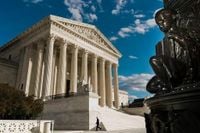In a move with far-reaching implications for the future of American governance, the Supreme Court has agreed to weigh whether President Donald Trump—and, by extension, future presidents—can fire independent agency officials at will, overturning nearly a century of legal precedent. The decision, announced on September 22, 2025, immediately allowed President Trump to remove Rebecca Slaughter, the lone Democrat on the Federal Trade Commission (FTC), even as litigation over her firing continues. The high court’s conservative majority, in a 6-3 split, signaled its willingness to reconsider the 1935 Humphrey’s Executor decision, which has long shielded independent agency commissioners from presidential removal except for cause such as misconduct or neglect of duty.
The case, which will be argued in December, has already stirred heated debate about the separation of powers and the independence of federal regulators. According to AP News, the Supreme Court’s order not only lifts a lower court’s block on Slaughter’s firing but also sets the stage for a possible seismic shift in the balance of power between Congress and the presidency. The court’s three liberal justices—Elena Kagan, Sonia Sotomayor, and Ketanji Brown Jackson—dissented strongly, warning that the majority’s approach could hand presidents unchecked authority over agencies designed to operate independently of political winds.
"Congress, as everyone agrees, prohibited each of those presidential removals," Justice Kagan wrote in her dissent, as cited by AP News. "Yet the majority, stay order by stay order, has handed full control of all those agencies to the President." She continued, "He may now remove—so says the majority, though Congress said differently—any member he wishes, for any reason or no reason at all. And he may thereby extinguish the agencies' bipartisanship and independence." Her words echoed the concerns of many legal scholars and lawmakers who fear that overturning Humphrey’s Executor would politicize regulatory bodies such as the FTC, the National Labor Relations Board (NLRB), and the Merit Systems Protection Board (MSPB).
The dispute began when President Trump, in March 2025, moved to oust Slaughter from her FTC post. Slaughter, first appointed by Trump in 2018 and reappointed by President Joe Biden to a term expiring in 2029, challenged the firing in court. She argued that her removal violated a 1914 law limiting such actions to instances of inefficiency, neglect of duty, or malfeasance. A federal judge sided with Slaughter in July, ordering her reinstatement, and an appellate panel refused to lift that order on September 2. However, Chief Justice John Roberts temporarily blocked her return on September 8, pending the Supreme Court’s review. When the full court’s majority weighed in on September 22, they cleared the way for her immediate removal, pending arguments in December.
The Trump administration has been eager for the Supreme Court to address the question of removal protections for independent agencies. In court filings, Solicitor General D. John Sauer argued that the modern FTC wields “substantial executive authority,” making it inappropriate for Congress to insulate its commissioners from at-will removal. He wrote, "The President and the government suffer irreparable harm when courts transfer even some of that executive power to officers beyond the President’s control," as reported by AP News. Sauer maintained that district courts lack the power to reinstate agency heads against the president’s wishes, echoing Justice Neil Gorsuch’s earlier opinion that fired employees could receive back pay but not reinstatement.
Attorney General Pam Bondi hailed the Supreme Court’s decision as a major victory for presidential authority. "This helps affirm our argument that the President, not a lower court judge, has hiring and firing power over executive officials," Bondi wrote on social media, according to CBS News. "We will continue fighting and winning in court to defend President Trump’s agenda." The administration’s position has found support among conservative legal theorists, who have long argued that independent agencies should answer directly to the elected president, not Congress.
But Slaughter’s attorneys and supporters see the issue very differently. They warn that allowing presidents to fire independent commissioners at will would undermine the expertise and impartiality that Congress intended for these agencies. "Congress gave independent regulators removal protections to preserve the integrity of our economy," her attorneys said in a statement cited by AP News. "Giving the executive branch unchecked power over who sits on these boards and commissions would have seismic implications for our economy that will harm ordinary Americans." Slaughter’s legal team also pointed out that for nearly 90 years, presidents of both parties—including Trump during his first term—respected the for-cause removal requirement for the FTC.
The Supreme Court’s willingness to revisit Humphrey’s Executor comes after a series of recent decisions chipping away at removal protections for independent agencies. In 2020, the court found the structure of the Consumer Financial Protection Bureau, led by a single director removable only for cause, to be unconstitutional. A year later, it ruled that the Federal Housing Finance Agency’s similar structure violated the separation of powers. Now, the question is whether the court will go further and strip away protections for multi-member commissions like the FTC.
The stakes are high. The FTC, NLRB, and MSPB play critical roles in enforcing consumer protection, antitrust laws, labor relations, and federal employment disputes. If the Supreme Court overturns Humphrey’s Executor, presidents could remove commissioners for any reason, potentially shifting these agencies from bipartisan, expertise-driven bodies to extensions of the executive branch. As MSNBC noted, the FTC currently has a three-Republican majority, so Slaughter’s removal may not immediately alter outcomes, but the precedent could have broad and lasting effects.
The court’s order also rejected requests from other independent agency members—Gwynne Wilcox of the NLRB and Cathy Harris of the MSPB—to have their cases heard alongside Slaughter’s. Their legal battles will continue in the lower courts, but the outcome of the Supreme Court’s decision in the FTC case will likely determine their fate as well.
Justice Brett Kavanaugh, concurring in a related case, warned that "the downsides of delay in definitively resolving the status of the precedent sometimes tend to outweigh the benefits of further lower-court consideration," as reported by CBS News. The Supreme Court’s next term begins in early October, with a final decision in the Slaughter case expected by July 2026.
As the court prepares to hear arguments in December, both sides are bracing for a landmark ruling that could redefine the relationship between Congress, the president, and the independent agencies that regulate vast swaths of American life. Whether the justices will preserve the delicate balance of power or tip the scales decisively toward the executive branch remains to be seen, but the consequences for the nation’s regulatory framework could be profound.


